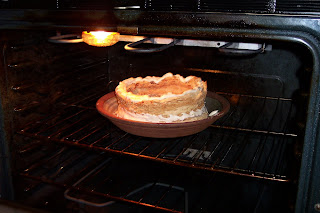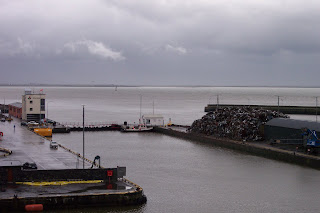Spanische Windtorte
When I was young, my mother had a nearly-complete set of the Time-Life Foods of the World cookbooks. Although the recipes in these were not, as a rule, very good, I was much taken with the photo on the cover of The Cooking of Vienna's Empire -- a Spanish Windtorte. I told my mother that I wanted one for my birthday cake. I had not grasped quite how difficult they were to build. I think we wound up with more of a Pavlova instead.
The thing is, a Spanische Windtorte is almost exactly the same thing as a pavlova, only with a fancier-shaped meringue. So, when I set out to make one again yesterday, I used a combination of this Pavlova recipe and these Spanische Windtorte instructions. I increased the quantities in the pavlova recipe by about 1/3, and, in the final step, did not macerate the fruit but rather mixed it with sugar immediately before adding it to the whipped cream mixture... but I'm getting ahead of myself.
Making the meringue was fairly straightforward, except that I was using a bunch of small eggs from my brother's chickens. I am pretty OK at separating eggs, but I botched at least a third of the ones I tried to use yesterday. I think that part of the problem was that some of them were fertilized, which seems to make the yolk membrane more porous and easier to break. Anyway, somehow I managed to get a cup of egg white together and whip it up, as per the instructions in the pavlova recipe.
Then came the first tricky bit: Shaping the shell. I used about 1/4 of the meringue mix in each of two buttered, powdered-sugared, and parchment lined cake tins, and hit upon this inspired idea for the walls of the cake:
 That's a medium-sized souffle pan inside a 9" springform pan, with parchment paper on the bottom and around the souffle pan. You can see the buttering-flouring job better on the plain cake pan next to it. I jammed another 1/3 or so of the meringue mix into this mold. I used an improvised cake-decorating bag and my fingers for the job. I popped the meringue into the over at 250 Farenheit for half of forever, then jacked the temperature up to 275, because after an hour it was all still tacky. I suppose it didn't help that yesterday's humidity level was over 90%. Anyhow, it eventually came out looking like this:
That's a medium-sized souffle pan inside a 9" springform pan, with parchment paper on the bottom and around the souffle pan. You can see the buttering-flouring job better on the plain cake pan next to it. I jammed another 1/3 or so of the meringue mix into this mold. I used an improvised cake-decorating bag and my fingers for the job. I popped the meringue into the over at 250 Farenheit for half of forever, then jacked the temperature up to 275, because after an hour it was all still tacky. I suppose it didn't help that yesterday's humidity level was over 90%. Anyhow, it eventually came out looking like this:  I tacked it together and made a stab at decorating it using more of the meringue. Unfortunately, the meringue had softened a bit by this point, so it didn't hold those nice shell-shapes and stuff that you can see on the cover of Vienna's Empire. Still, it smoothed out a couple of the rough spots. Right before dinner, I stuck a few candied rose petals onto it and popped it back in the oven to stay dry.
I tacked it together and made a stab at decorating it using more of the meringue. Unfortunately, the meringue had softened a bit by this point, so it didn't hold those nice shell-shapes and stuff that you can see on the cover of Vienna's Empire. Still, it smoothed out a couple of the rough spots. Right before dinner, I stuck a few candied rose petals onto it and popped it back in the oven to stay dry.

We (meaning my mother, because I was calming Nova down after a tumble) whipped up the cream and sour cream right before serving the torte, and I mixed in most of the fruit. Nova checked to make sure the whipped cream was OK:

The final result was this:

It's not like the photo at the top of this post, but the last-minute addition of fruit and a bit of delicate balancing made it pretty enough.
As for the taste: Meringue, whipped cream, fruit... need I say more? Well, yes. There were a few twists in the end. The pavlova recipe I used called for brown sugar in the meringue, which gave a bit of a toasted marshmallow taste to things. Unfortunately, the many steps involved with making the cake into a decorated shell shape lead to about three hours total in the oven, after which it wasn't gooey inside, which was too bad. The candied rose petals went onto the meringue about an hour or two before we served the desert, and it sat in a warm oven through dinner. The scent of the rose petals (picked and candied earlier this summer by my mother) suffused the meringue. One of our guests said that it tasted "like the beach." Roses, toasted marshmallows, and fruit. Yup.
I might even make this again, and I'm glad there were lots of people on hand to entertain Nova while I was in the kitchen all day!

Comments